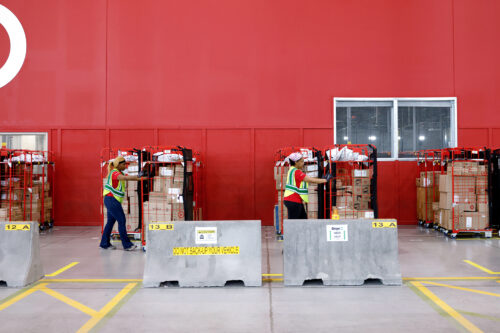Target Expands Next-Day Delivery, Raising the Stakes in Retail Logistics

The retail giant is shifting its fulfillment model to reach more customers, faster.
By IL Editors | September 17, 2025
Target is ramping up its ecommerce game with a plan to roll out next-day parcel delivery across 35 of the country’s 60 largest metro areas by the end of October. Once complete, the expansion will put more than half of U.S. households—about 54%—within reach of next-day service, a big leap from the 20% coverage it offers today.
The expansion is part of Target’s broader pivot toward a “market-based” fulfillment model. Instead of relying on large, centralized distribution centers, Target is leaning on its vast store network and a growing roster of sortation hubs to get packages to doorsteps faster. The model isn’t one-size-fits-all: it varies by city, with Target tailoring its operations to meet local demand.
Chicago offers a glimpse of what this looks like in practice. Target cut back on the number of stores handling shipping—from 18 down to six—and saw delivery times shrink and costs come down. The reworked system also frees up many stores to refocus on what they were built for: serving in-store customers, while select locations take on more of the shipping load.
The Balancing Act
The push into next-day fills an important gap between the same-day delivery Target offers through Shipt, which already covers 80% of U.S. households, and its two-day service, which reaches nearly everyone. Same-day is convenient but expensive to scale; two-day is efficient but doesn’t always meet customer expectations. Next-day offers a middle ground—fast enough to keep shoppers happy, but designed to be more sustainable from a cost standpoint.
Of course, speed has its price. Retailers know consumers expect deliveries faster than ever, but logistics teams are under pressure to find ways to deliver without losing margin. Target believes its stores-as-hubs strategy—placing inventory closer to shoppers and trimming last-mile costs—is the right formula.
The Bigger Picture

Target’s announcement comes as competition in retail logistics heats up. Amazon continues to set the pace on delivery speed, while Walmart and others are investing heavily in new fulfillment models. The message is clear: in today’s market, fast shipping isn’t just a nice-to-have; it’s a must-have.
For logistics networks, that means:
- Getting smarter about forecasting and routing, so trucks and couriers aren’t driving empty miles.
- Finding the right balance between retail operations and shipping demands as stores double as mini-warehouses.
- Investing in tech tools—from real-time visibility platforms to AI-driven planning—that can help manage the complexity of faster fulfillment.
What Comes Next
With this next-day push, Target is betting that speed can still be a competitive advantage—if it’s done in a way that keeps costs in check. The company’s strategy will be closely watched, not only by consumers eager for faster deliveries, but also by supply chain professionals looking for clues on how to adapt networks to meet rising expectations without breaking the bank.
3 Key Takeaways for Logistics Professionals
- Next-day is the new middle ground. Retailers are carving out a space between costly same-day and slower two-day services, creating new pressures on fulfillment networks.
- Stores continue to double as warehouses. Using retail space for shipping is becoming a common tactic—but it requires careful planning to balance in-store and online demand.
- Technology is critical. From AI forecasting to last-mile visibility, digital tools are no longer optional for keeping pace with faster delivery promises.
